At the Corner of Washington and Summer
Examining 250 years of Boston history from a single downtown block
Welcome to the Quarantine Creatives newsletter, a companion to my podcast of the same name, which explores creativity, art, and big ideas as we continue to live through this pandemic.
If you like what you’re reading, you can subscribe for free to have this newsletter delivered to your inbox on Wednesdays and Sundays:

Last week, I discussed some of the unexpected surprises I found while walking around Laconia, New Hampshire for an afternoon. Since then, I have been trying to be a bit more observant of my surroundings and attuned to the history in everyday places.
I recently found myself walking through Boston’s Downtown Crossing neighborhood, a busy shopping district made up of department stores, clothing chains, and fast food restaurants.
As I passed by Macy’s, which sits at the corner of Washington and Summer Streets, I noticed a small plaque mounted on the wall that I had passed dozens of times but somehow had never seen before.
It turns out that this Macy’s wasn’t always a department store. This was once the location of a parsonage where Ralph Waldo Emerson was born in 1803.
This piqued my curiosity in many ways. Emerson’s adult home still stands as a museum in nearby Concord, MA. Many of his contemporary writers, including Louisa May Alcott and Nathaniel Hawthorne also have their Concord homes preserved (and Henry David Thoreau’s Walden cabin is recreated at Walden Pond). I firmly associate Emerson with the more rural character of Concord and never thought of him as a city dweller.
Imaging the Boston of Emerson in 1803 led me to investigate the history of Downtown Crossing. Today, I’d like to share a portrait of that neighborhood over the last 250 years, with a particular focus on a roughly one block radius around the intersection of Washington Street and Summer Street. The changes that took place in this area are emblematic of larger shifts in our nation and show our evolving relationship to home, commerce, safety, and building.

In the early days of the city of Boston, the area now known as Downtown Crossing seems practically pastoral. At the time the above map was made in 1769, Summer Street looks to be residential, with homes spaced out, large yards, and even a pond in what would today be Macy’s fragrance department.
According to one account, Summer Street was the address for prominent Bostonians in the early years of our republic, including four U.S. Senators, a U.S. Speaker of the House, Secretary of State Daniel Webster, and Boston’s longest serving mayor, Josiah Quincy.
You may also notice on the map that modern day Washington Street was known as Marlborough Street and Newbury Street at the time. Both streets were renamed to Washington Street in 1789 when George Washington visited Boston. (Marlborough Street and Newbury Street were names later given to streets in the Back Bay neighborhood, which was created in the 1850s).
When Ralph Waldo Emerson was born at the church home on Summer Street in 1803, his father, William Emerson, was the minister of the First Church of Boston. That congregation was originally founded by John Winthrop in 1630 upon landing in Boston.
The First Church moved several times over the years, even locating on Summer Street in 1807, soon after Emerson’s birth. The church remained in that location until 1868, when the congregation relocated to the Back Bay. It is still an active Unitarian Universalist congregation.

After the Civil War, Boston saw an influx of development and it grew into a commercial hub, but with greater density came certain risks.
Exactly 150 years ago, on November 9, 1872, a fire began at 83-85 Summer Street, about a block from Emerson’s birth place. The fire quickly spread to nearby buildings and burned for about fifteen hours before being brought under control.
Even though most of the buildings in this area were brick, the fashionable mansard roofs of the time were made of wood. The fire was able to travel from roof to roof, and the narrow streets and tight buildings helped it spread quickly.
The city’s water mains were not able to provide sufficient pressure to adequately fight the fire. In addition, the horses that firefighters used to move equipment were sick with a flu epidemic. An estimated 30 people died, including 11 firefighters.
According to the Boston Fire Historical Society:
“The fire destroyed 776 buildings across 65 acres of land, with the assessed value of the properties at nearly $13.5 million and personal property loss of of $60 million dollars.”
The area that is now Downtown Crossing was completely destroyed by the fire, including both sides of Summer Street all the way to Boston Harbor.
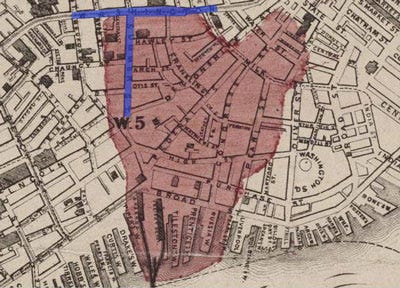
Boston was quick to rebuild this commercial district, as consumer demand for shopping outlets was increasing significantly during the late 1800s.
On the same Macy’s building with the Emerson memorial sign is another plaque that symbolizes the commercial history of this neighborhood. The department store Jordan Marsh was founded in 1851 when Eben Jordan and Benjamin L. Marsh started a wholesale textiles business. They shifted to retail sales and moved to Washington Street in 1861, where the business remained until it was converted to a Macy’s in 1996.
According to Mass Moments, Jordan Marsh introduced many ideas that became nationwide retail standards:
“Jordan Marsh also pioneered new services for shoppers not available in more traditional specialty shops. Most important, it offered credit, usually in the form of charge accounts. It introduced the customer-is-always right policy, and offered money-back guarantees when most other retailers predicted the practice would lead to bankruptcy.”
In 1880, Jordan Marsh opened a brand new building with a large clocktower on Washington Street. This became known as the “main store.”

In 1947, construction began on what became known as the “new store” at the corner of Summer and Chauncey Streets (the site of Emerson’s birthplace more than 100 years earlier). The several buildings that made up Jordan Marsh throughout downtown were connected by underground tunnels and a three-story pedestrian bridge over Avon Street.
The original main store was torn down in 1976. By this era, the glamor and novelty of shopping downtown had started to fade. Jordan Marsh was sold to Macy’s parent company Federated Department Stores in 1988 and was fully converted to Macy’s in 1996 when the Jordan Marsh brand was officially retired.
Jordan Marsh was not the only prominent department store in Downtown Crossing. Directly across Summer Street was the home of another once-great New England department store, Filene’s. William Filene began his retailing career in 1849 on Washington Street, although that store was short lived. He returned to the same neighborhood in 1890 and opened a store that initially trafficked in women’s clothing.
Filene’s built their flagship store in 1912 designed by Chicago architect Daniel Hudson Burnham, who also designed the World’s Fair buildings and Marshall Field’s main store in Chicago, plus Gimbel’s and the original Penn Station in New York. The Filene’s facade is still standing today, directly across from Macy’s.
Filene’s was famous for its discount basement, where clothing was automatically marked down based on how long it sat on the rack. Filene’s Basement was also home since 1947 to an annual event which became dubbed the “Running of the Brides” where bridal gowns were sold at steep discounts.
Portions of Filene’s were torn down in 1972, replaced by a brutalist concrete building that looked more at home in a suburban shopping mall than a city. Luckily, the 1912 portion of the building was retained.
Like Jordan Marsh, Filene’s was eventually consolidated with other department stores. It was sold briefly to Macy’s parent company Federated in 1988, before being spun off to May Company that same year. May Company was eventually sold to Federated in 2005. While many suburban Filene’s locations were converted to Macy’s, the location in Downtown Crossing permanently closed because there was already a Macy’s across the street (the former Jordan Marsh). Filene’s Basement had been spun off as a separate brand, but it left Downtown Crossing in 2007 and permanently closed all locations in 2011.
There were plans to turn the Filene’s site into a mixed use shopping and residential complex and work began in 2007 with the demolition of the 1976 addition. Financing for the project dried up during the financial crisis of 2008, leaving a large hole in the middle of Downtown Crossing. Work finally resumed in 2012.

Today, work on the old Filene’s site is complete, and it shows how the face of retailing has evolved over the last century. Shoppers no longer seek out large department stores, and instead gravitate to specialty retailers and fast fashion outlets. What was once a full city block of Filene’s is now home to several different stores, including Old Navy, Primark, and local supermarket chain Roche Brothers.
Towering above the shops is a new mixed use skyscraper known as Millennium Tower, the fourth tallest building in Boston. Millennium Tower’s penthouse sold for $35 million in 2016, making it one of the most expensive residential sales in Boston’s history. Perhaps this is a fitting end to our exploration of the intersection of Washington and Summer Street- an area that once housed the wealthy elite of Boston is once again home to some of the most expensive real estate in the city.
The style of shopping may have changed over the years, but the need to have a dedicated place to seek out the latest trends and an affordable price is still with us.
Had I not happened to notice that plaque with Emerson’s face on it the other day, I would have not taken the time to dig a little deeper into the history of this neighborhood. It’s a good reminder that every part of our built environment has a story to tell, from the streets and street names to the houses, shops, and office buildings. They are part of the fabric of the larger community and reflect the current tastes and trends of the era.
It’s also a reminder that nothing is permanent, despite our desire for preservation. Places evolve and change because of changing economics, and because of unexpected events, like fires. Personally, I like when elements of the past are able to be integrated into a new design, like how the historic Filene’s facade blends with the reflective glass of the Millennium Tower, but that approach is not always possible or practical.
As shopping continues to move online and businesses become less tethered to a physical office space, it will be interesting to watch how Downtown Crossing (and the neighborhoods like it across the country) adapt and change. Perhaps one day, the plaques commemorating Emerson’s birth site and Jordan Marsh will be moved onto an entirely new building with a use that we cannot even imagine yet.
Do you know any interesting history about the places around you? Have you seen the downtown shopping district change in your lifetime? Do you miss shopping in the city center? Drop a comment to share your thoughts.
Related Reading
If you’d like to catch up on past episodes of the Quarantine Creatives podcast, they can be found on Apple Podcasts, Spotify, or wherever you listen.
If you’ve missed past issues of this newsletter, they are available to read here.
Stay Safe!
Heath


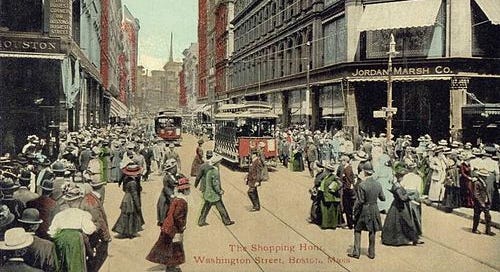


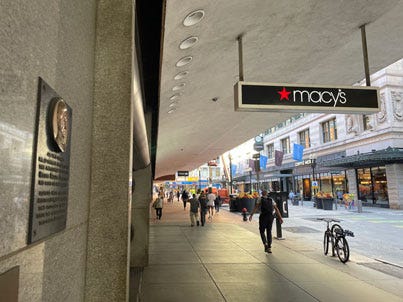
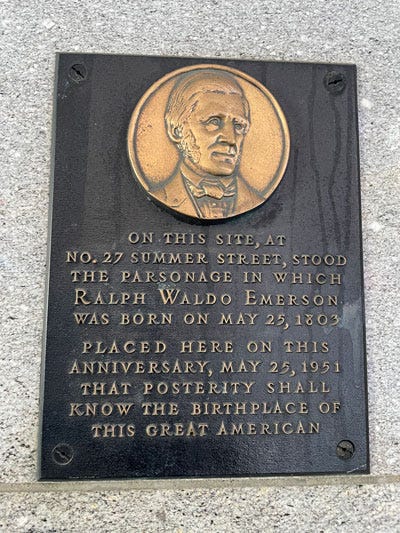
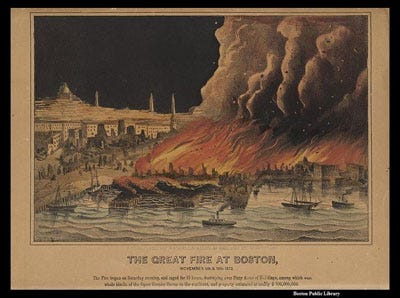
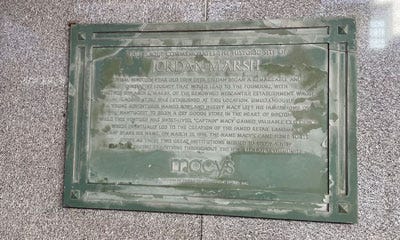
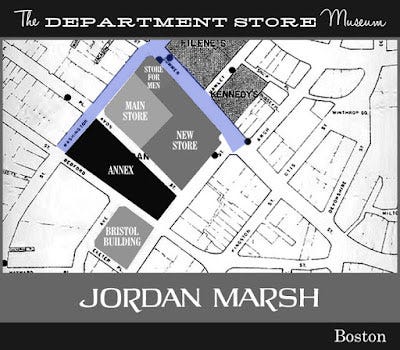
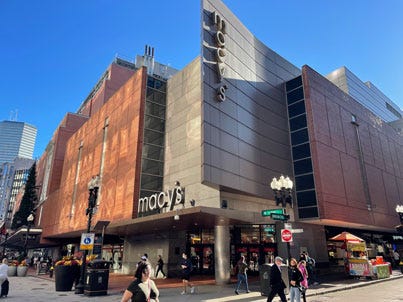



I am indebted to you for this post. I was trying to find the location of Emerson's birthplace and your post verified that it's currently occupied by Macy's.
I miss Filenes Basement. So many of my clothes as a child were purchased there!